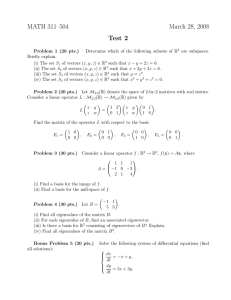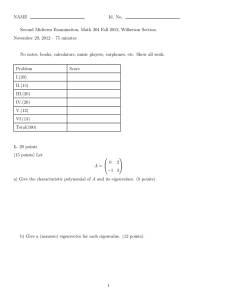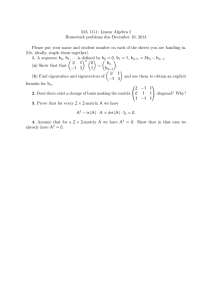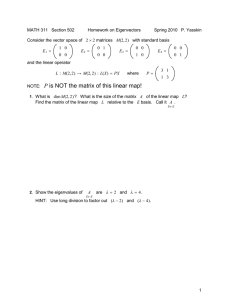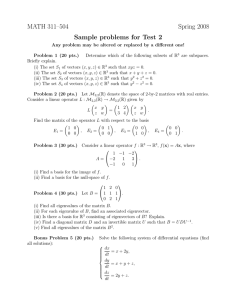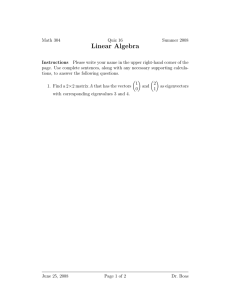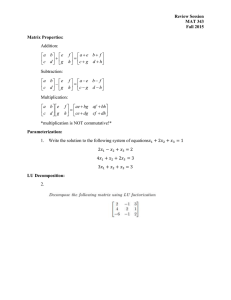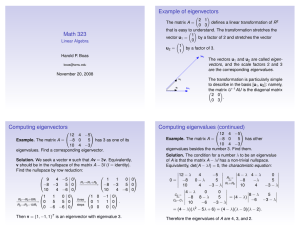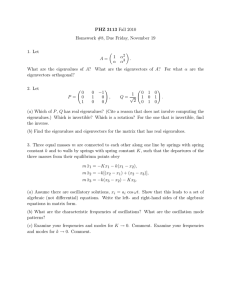MATH 311-504 Topics in Applied Mathematics Lecture 2-13: Review for Test 2.
advertisement
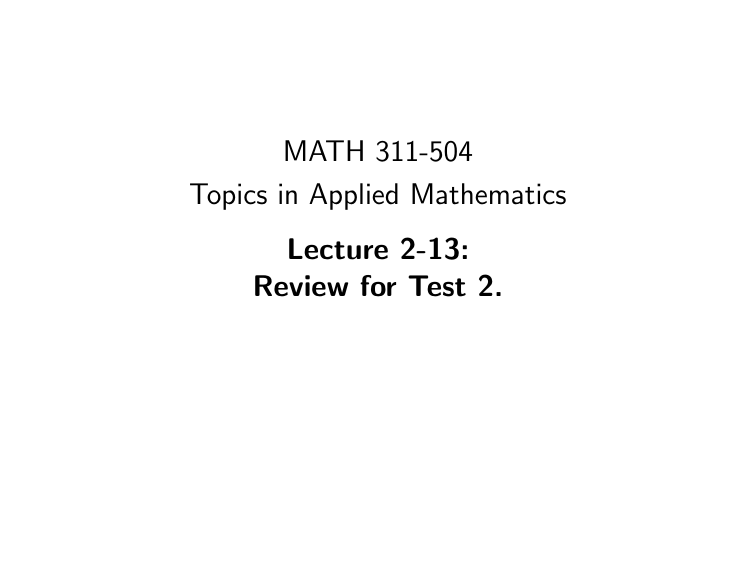
MATH 311-504 Topics in Applied Mathematics Lecture 2-13: Review for Test 2. Topics for Test 2 Vector spaces and linear transformations (Williamson/Trotter 3.1–3.4) • Vector spaces. Subspaces. • Linear mappings. Matrix transformations. • Span. Image and null-space. • Linear independence (especially in functional spaces). Basis, dimension, coordinates (Williamson/Trotter 3.5, 3.6C) • Basis of a vector space. Dimension. • Matrix of a linear transformation. • Change of coordinates. Eigenvalues and eigenvectors (Williamson/Trotter 3.6) • Eigenvalues, eigenvectors, eigenspaces. • Characteristic equation of a matrix. • Bases of eigenvectors, diagonalization. Sample problems for Test 2 Problem 1 (20 pts.) Determine which of the following subsets of R3 are subspaces. Briefly explain. (i) The set S1 of vectors (x, y , z) ∈ R3 such that xyz = 0. (ii) The set S2 of vectors (x, y , z) ∈ R3 such that x + y + z = 0. (iii) The set S3 of vectors (x, y , z) ∈ R3 such that y 2 + z 2 = 0. (iv) The set S4 of vectors (x, y , z) ∈ R3 such that y 2 − z 2 = 0. Sample problems for Test 2 Problem 2 (20 pts.) Let M2,2 (R) denote the space of 2-by-2 matrices with real entries. Consider a linear operator L : M2,2 (R) → M2,2 (R) given by x y 1 2 x y L = . z w 3 4 z w Find the matrix of the operator L with respect to the basis 1 0 0 1 0 0 0 0 E1 = , E2 = , E3 = , E4 = . 0 0 0 0 1 0 0 1 Sample problems for Test 2 Problem 3 (30 pts.) Consider a linear operator f : R3 → R3 , f (x) = Ax, where 1 −1 −2 A = −2 1 3 . −1 0 1 (i) Find a basis for the image of f . (ii) Find a basis for the null-space of f . Sample problems for Test 2 1 2 0 Problem 4 (30 pts.) Let B = 1 1 1. 0 2 1 (i) Find all eigenvalues of the matrix B. (ii) For each eigenvalue of B, find an associated eigenvector. (iii) Is there a basis for R3 consisting of eigenvectors of B? Explain. (iv) Find a diagonal matrix D and an invertible matrix U such that B = UDU −1 . (v) Find all eigenvalues of the matrix B 2 . Sample problems for Test 2 Bonus Problem 5 (20 pts.) Solve the following system of differential equations (find all solutions): dx = x + 2y , dt dy = x + y + z, dt dz = 2y + z. dt Problem 1. Determine which of the following subsets of R3 are subspaces. Briefly explain. A subset of R3 is a subspace if it is closed under addition and scalar multiplication. Besides, the subset must not be empty. (i) The set S1 of vectors (x, y , z) ∈ R3 such that xyz = 0. (0, 0, 0) ∈ S1 =⇒ S1 is not empty. xyz = 0 =⇒ (rx)(ry )(rz) = r 3 xyz = 0. That is, v = (x, y , z) ∈ S1 =⇒ r v = (rx, ry , rz) ∈ S1 . Hence S1 is closed under scalar multiplication. However S1 is not closed under addition. Counterexample: (1, 1, 0) + (0, 0, 1) = (1, 1, 1). Problem 1. Determine which of the following subsets of R3 are subspaces. Briefly explain. A subset of R3 is a subspace if it is closed under addition and scalar multiplication. Besides, the subset must not be empty. (ii) The set S2 of vectors (x, y , z) ∈ R3 such that x + y + z = 0. (0, 0, 0) ∈ S2 =⇒ S2 is not empty. x + y + z = 0 =⇒ rx + ry + rz = r (x + y + z) = 0. Hence S2 is closed under scalar multiplication. x + y + z = x ′ + y ′ + z ′ = 0 =⇒ (x + x ′ ) + (y + y ′ ) + (z + z ′ ) = (x + y + z) + (x ′ + y ′ + z ′ ) = 0. That is, v = (x, y , z), v′ = (x, y , z) ∈ S2 =⇒ v + v′ = (x + x ′ , y + y ′ , z + z ′ ) ∈ S2 . Hence S2 is closed under addition. (iii) The set S3 of vectors (x, y , z) ∈ R3 such that y 2 + z 2 = 0. y 2 + z 2 = 0 ⇐⇒ y = z = 0. S3 is a nonempty set closed under addition and scalar multiplication. (iv) The set S4 of vectors (x, y , z) ∈ R3 such that y 2 − z 2 = 0. S4 is a nonempty set closed under scalar multiplication. However S4 is not closed under addition. Counterexample: (0, 1, 1) + (0, 1, −1) = (0, 2, 0). Problem 2. Let M2,2 (R) denote the vector space of 2×2 matrices with real entries. Consider a linear operator L : M2,2 (R) → M2,2 (R) given by x y 1 2 x y . = L z w 3 4 z w Find the matrix of the operator L with respect to the basis 0 0 0 0 0 1 1 0 . , E4 = , E3 = , E2 = E1 = 0 1 1 0 0 0 0 0 Let ML denote the desired matrix. By definition, ML is a 4×4 matrix whose columns are coordinates of the matrices L(E1 ), L(E2 ), L(E3 ), L(E4 ) with respect to the basis E1 , E2 , E3 , E4 . L(E1 ) = 1 2 3 4 1 0 0 0 L(E2 ) = 1 2 3 4 0 1 0 0 L(E3 ) = 1 2 3 4 0 0 1 0 L(E4 ) = 1 2 3 4 0 0 0 1 It follows that = 1 0 3 0 = 1E1 +0E2 +3E3 +0E4 , = 0 1 0 3 = 0E1 +1E2 +0E3 +3E4 , = 2 0 4 0 = 2E1 +0E2 +4E3 +0E4 , = 0 2 0 4 = 0E1 +2E2 +0E3 +4E4 . 1 0 ML = 3 0 0 1 0 3 2 0 4 0 0 2 . 0 4 Thus the relation x1 y1 1 2 x y = 3 4 z w z1 w1 is equivalent to the relation x1 1 0 y1 0 1 = z1 3 0 0 3 w1 2 0 4 0 x 0 2 y . 0 z w 4 Problem 3. Consider a linear operator f : R3 → R3 , 1 −1 −2 1 3 . f (x) = Ax, where A = −2 −1 0 1 (i) Find a basis for the image of f . The image of f is spanned by columns of the matrix A: v1 = (1, −2, −1), v2 = (−1, 1, 0), v3 = (−2, 3, 1). 1 −1 −2 1 −1 −1 −2 = 0. 1 3 = −1 det A = −2 + 1 −2 1 1 3 −1 0 1 Hence v1 , v2 , v3 are linearly dependent. It is easy to observe that v2 = v1 + v3 . It follows that Span(v1 , v2 , v3 ) = Span(v1 , v3 ). Since the vectors v1 and v3 are linearly independent, they form a basis for the image of f . Problem 3. Consider a linear operator f : R3 → R3 , 1 −1 −2 1 3 . f (x) = Ax, where A = −2 −1 0 1 (ii) Find a basis for the null-space of f . The null-space of f is the set of solutions of the vector equation Ax = 0. To solve the equation, we convert the matrix A to reduced row echelon form: 1 −1 −2 1 −1 −2 1 −1 −2 −2 1 3 → 0 −1 −1 → 0 −1 −1 0 0 0 0 −1 −1 −1 0 1 1 0 −1 1 −1 −2 x − z = 0, 1 → 1 1 → 0 1 → 0 y + z = 0. 0 0 0 0 0 0 General solution: (x, y , z) = (t, −t, t) = t(1, −1, 1), t ∈ R. Hence the null-space is a line and (1, −1, 1) is its basis. 1 2 0 Problem 4. Let B = 1 1 1 . 0 2 1 (i) Find all eigenvalues of the matrix B. The eigenvalues of B are roots of the characteristic equation det(B − λI ) = 0. We obtain that 1−λ 2 0 1−λ 1 det(B − λI ) = 1 0 2 1−λ = (1 − λ)3 − 2(1 − λ) − 2(1 − λ) = (1 − λ) (1 − λ)2 − 4 = (1 − λ) (1 − λ) − 2 (1 − λ) + 2 = −(λ − 1)(λ + 1)(λ − 3). Hence the matrix B has three eigenvalues: −1, 1, and 3. 1 2 0 Problem 4. Let B = 1 1 1 . 0 2 1 (ii) For each eigenvalue of B, find an associated eigenvector. An eigenvector v = (x, y , z) of the matrix B associated with an eigenvalue λ is a nonzero solution of the vector equation 0 x 1−λ 2 0 1−λ 1 y = 0 . (B −λI )v = 0 ⇐⇒ 1 0 z 0 2 1−λ To solve the equation, we convert the matrix B − λI to reduced row echelon form. First consider the case λ = −1. The row 1 2 2 0 B +I = 1 2 1 → 1 0 0 2 2 reduction yields 1 0 2 1 2 2 1 1 0 1 1 0 1 0 −1 1 . → 0 1 1 → 0 1 1 → 0 1 0 0 0 0 2 2 0 0 0 Hence (B + I )v = 0 ⇐⇒ x − z = 0, y + z = 0. The general solution is x = t, y = −t, z = t, where t ∈ R. In particular, v1 = (1, −1, 1) is an eigenvector of B associated with the eigenvalue −1. Secondly, consider the case λ = 1. The row reduction yields 0 B − I = 1 0 1 0 2 0 0 1 → 0 2 0 2 2 0 1 0 1 0 → 0 1 0 2 0 Hence (B − I )v = 0 ⇐⇒ 1 1 0 0 → 0 1 0 0 0 1 0 . 0 x + z = 0, y = 0. The general solution is x = −t, y = 0, z = t, where t ∈ R. In particular, v2 = (−1, 0, 1) is an eigenvector of B associated with the eigenvalue 1. Finally, consider the case λ = 3. The row reduction yields 1 −1 0 1 −1 0 −2 2 0 1 1 → 0 −1 1 → 1 −2 B−3I = 1 −2 0 2 −2 0 2 −2 0 2 −2 1 0 −1 1 −1 0 1 −1 0 1 −1 → 0 1 −1 → 0 1 −1 . → 0 0 0 0 0 2 −2 0 0 0 Hence (B − 3I )v = 0 ⇐⇒ x − z = 0, y − z = 0. The general solution is x = t, y = t, z = t, where t ∈ R. In particular, v3 = (1, 1, 1) is an eigenvector of B associated with the eigenvalue 3. 1 2 0 Problem 4. Let B = 1 1 1 . 0 2 1 (iii) Is there a basis for R3 consisting of eigenvectors of B? Explain. The vectors v1 = (1, −1, 1), v2 = (−1, 0, 1), and v3 = (1, 1, 1) are eigenvectors of the matrix B belonging to distinct eigenvalues. Therefore these vectors are linearly independent. It follows that v1 , v2 , v3 is a basis for R3 . Alternatively, the existence of a basis for R3 consisting of eigenvectors of B already follows from the fact that the matrix B has three distinct eigenvalues. 1 2 0 Problem 4. Let B = 1 1 1 . 0 2 1 (iv) Find a diagonal matrix D and an invertible matrix U such that B = UDU −1 . Basis of eigenvectors: v1 = (1, −1, 1), v2 = (−1, 0, 1), v3 = (1, 1, 1). We have that B = UDU −1 , where 1 −1 1 −1 0 0 0 1 . D = 0 1 0 , U = −1 1 1 1 0 0 3 Here D is the matrix of the linear operator L : R3 → R3 , L(x) = Bx with respect to the basis v1 , v2 , v3 while U is the transition matrix from v1 , v2 , v3 to the standard basis. 1 2 0 Problem 4. Let B = 1 1 1 . 0 2 1 (v) Find all eigenvalues of the matrix B 2 . Suppose that Bv = λv for some v ∈ R3 and λ ∈ R. Then B 2 v = B(Bv) = B(λv) = λ(Bv) = λ2 v. It follows that (−1)2 = 12 = 1 and 32 = 9 are eigenvalues of the matrix B 2 . These are the only eigenvalues of B 2 . Indeed, assume that B 2 v = µv, where v 6= 0. We have v = r1 v1 + r2 v2 + r3 v3 for some r1 , r2 , r3 ∈ R3 . Then B 2 v = r1 (B 2 v1 ) + r2 (B 2 v2 ) + r3 (B 2 v3 ) = r1 v1 + r2 v2 + 9r3 v3 , µv = µr1 v1 + µr2 v2 + µr3 v3 . =⇒ r1 = µr1 , r2 = µr2 , 9r3 = µr3 =⇒ (µ − 1)r1 = (µ − 1)r2 = (µ − 9)r3 = 0 =⇒ µ = 1 or µ = 9 Bonus Problem 5. Solve the following system of differential equations (find all solutions): dx = x + 2y , dt dy dt = x + y + z, dz dt = 2y + z. Let v = (x, y , z). Then the system rewritten in vector form 1 dv = Bv, where B = 1 dt 0 can be 2 0 1 1 . 2 1 Matrix B admits a basis of eigenvectors: v1 = (1, −1, 1), v2 = (−1, 0, 1), v3 = (1, 1, 1). We have Bv1 = −v1 , Bv2 = v2 , Bv3 = 3v3 . The vector-function v(t) is uniquely represented as v(t) = r1 (t)v1 + r2 (t)v2 + r3 (t)v3 , where r1 (t), r2 (t), and r3 (t) are scalar functions. dv dt = dr1 dt v1 + dr2 dt v2 + dr3 dt v3 , Bv = r1 Bv1 +r2 Bv2 +r3 Bv3 = −r1 v1 +r2 v2 +3r3 v3 . dr1 dt = −r1 , dv dr2 = Bv ⇐⇒ dt = r2 , dt dr3 dt = 3r3 . The general solution: r1 (t) = c1 e −t , r2 (t) = c2 e t , r3 (t) = c3 e 3t , where c1 , c2 , c3 are arbitrary constants. Thus v(t) = r1 (t)v1 + r2 (t)v2 + r3 (t)v3 = = c1 e −t (1, −1, 1) + c2 e t (−1, 0, 1) + c3 e 3t (1, 1, 1). −t t 3t x(t) = c1 e − c2 e + c3 e , y (t) = −c1 e −t + c3 e 3t , z(t) = c e −t + c e t + c e 3t . 1 2 3
